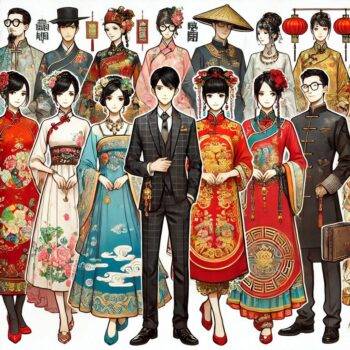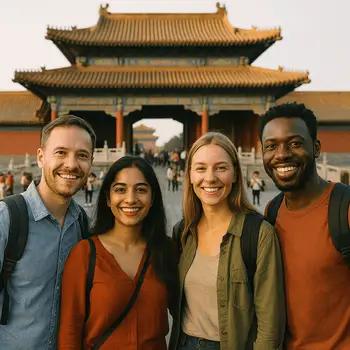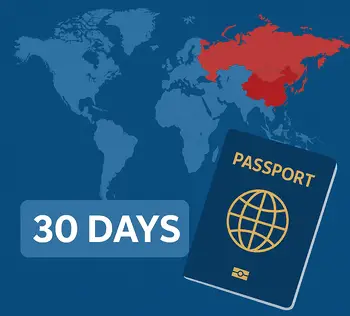
China’s fashion history is a rich tapestry of tradition, symbolism, and evolving aesthetics that spans thousands of years.
From ancient imperial robes to contemporary designs influenced by globalization, Chinese clothing reflects the values, status, and social hierarchy central to its civilization.
This article explores the historical significance of traditional attire, modern trends, and the global influence of Chinese fashion, while also offering insights into how to respectfully embrace it.
The Historical Significance of Traditional Chinese Attire
Hanfu: The Ancient Essence of Chinese Fashion
Hanfu, the traditional dress of the Han Chinese, dates back over 4,000 years, with its roots in the Han dynasty (206 BCE–220 CE).
It is characterized by flowing lines, wide sleeves, and intricate embroidery, embodying Confucian values such as modesty, harmony, and respect.
- Design and Symbolism: Hanfu typically consists of three main components: an inner shirt, a robe, and a waistband. The colors and patterns on Hanfu often symbolized social status, marital status, or special occasions. For example, dragons embroidered on imperial robes signified power and authority, while peonies represented wealth and honor.
- Cultural Revival: In recent years, Hanfu has experienced a resurgence among younger generations, who wear it during traditional festivals, cultural events, and even in daily life. This revival is fueled by social media platforms like Weibo and Douyin, where enthusiasts share their passion for traditional Chinese culture. Learn more about the Hanfu movement here.
The Qing Dynasty and the Rise of Qipao
The Qing dynasty (1644–1912) introduced the Qipao (or Cheongsam), a garment originally worn by Manchu women.
Initially loose-fitting, the Qipao evolved into a more form-fitting dress in the early 20th century, blending traditional Chinese aesthetics with modern tailoring.
- Elegant Simplicity: The Qipao is known for its high collar, asymmetrical openings, and intricate silk embroidery. It represents a balance between tradition and modernity, making it a timeless symbol of Chinese elegance.
- Cultural Export: Today, the Qipao is a global icon of Chinese fashion, often worn at formal events and by performers in traditional Chinese arts. Designers like Shanghai Tang have modernized the Qipao for contemporary audiences. Explore modern Qipao designs here.
Symbolism in Chinese Fashion
Colors and Their Meanings
In Chinese culture, colors carry profound symbolic meanings, often tied to traditional beliefs and customs.
- Red: The most auspicious color, symbolizing prosperity, happiness, and luck. It is a staple in weddings, Lunar New Year celebrations, and other festive occasions.
- Yellow: Historically reserved for emperors, yellow signifies power, wealth, and authority.
- Black and White: Black is associated with water and neutrality, while white often symbolizes mourning and purity. However, in modern contexts, white is also used in weddings and fashion.
Patterns and Embroidery
Patterns in Chinese clothing are deeply symbolic. For example:
- Dragons: Represent power, strength, and imperial authority.
- Phoenixes: Symbolize grace, femininity, and harmony.
- Peonies: Denote wealth, honor, and beauty.
These motifs are often embroidered onto garments, showcasing the artistry of traditional Chinese craftsmanship. Learn more about Chinese embroidery techniques here.
Modern Chinese Fashion Trends
Fusion of Tradition and Contemporary Style
Modern Chinese fashion reflects a blend of heritage and modern aesthetics.
Designers are increasingly incorporating traditional elements like Hanfu silhouettes, dragon motifs, and intricate embroidery into contemporary designs.
- Streetwear Meets Tradition: Younger generations are embracing a mix of urban streetwear and traditional fabrics or cuts. For example, brands like Li-Ning and Angel Chen have gained popularity for their innovative designs that merge Chinese heritage with global trends.
- Eco-Friendly Focus: Sustainability is becoming a priority in Chinese fashion, with designers turning to organic materials and eco-conscious production methods. Read about sustainable fashion in China here.
Global Influence of Chinese Fashion Designers
Chinese designers like Guo Pei, known for her opulent couture gowns, and Angel Chen, celebrated for her bold, youthful designs, have gained international acclaim.
Their work highlights the global appeal of Chinese craftsmanship and creativity. Discover Guo Pei’s work here.
Dress Codes in Traditional Chinese Ceremonies
Weddings
Traditional Chinese wedding attire is vibrant and symbolic.
Brides often wear a red Qun Kwa, a two-piece ensemble adorned with gold embroidery, symbolizing marital harmony and prosperity.
Grooms may wear matching red robes or modern suits with traditional elements.
Festivals
During festivals like Lunar New Year and the Mid-Autumn Festival, celebratory attire often includes red Hanfu or Qipao, paired with gold accessories.
These garments reflect the festive spirit and bring good fortune.
Religious and Cultural Observances
In Confucian and Taoist ceremonies, participants wear simple, modest clothing in neutral tones, reflecting the spiritual focus of the occasion.
For example, white or gray robes are common in Taoist rituals.
Cultural Influence on Global Fashion
Chinese-inspired fashion has gained significant traction worldwide.
Elements like silk fabrics, intricate patterns, and traditional cuts are frequently showcased in international fashion weeks.
- Hollywood Glamour: Celebrities like Fan Bingbing and Zendaya have worn Chinese-inspired designs on red carpets, elevating their prestige.
- Fast Fashion Integration: Affordable brands like Zara and H&M have incorporated Chinese motifs into their collections, making traditional designs accessible to the masses. However, this raises questions about cultural appropriation versus appreciation.
How to Respectfully Embrace Chinese Fashion
Adopting Chinese fashion requires cultural sensitivity and an understanding of its rich history.
Here are some tips:
- Educate Yourself: Learn the meanings behind specific designs, colors, and patterns to avoid misrepresentation. For example, wearing a Qipao at a formal event is appropriate, but using it as a costume may be seen as disrespectful.
- Support Local Artisans: Purchasing from authentic Chinese designers and craftspeople helps preserve traditional techniques and supports local economies.
- Celebrate, Don’t Appropriate: Wearing Chinese attire should be an homage to its cultural significance, not a superficial trend. Read more about cultural appropriation here.
Conclusion
China’s dress codes and fashion are a testament to the country’s cultural depth and adaptability.
From the elegant Hanfu to the modern interpretations of Qipao, Chinese clothing is a blend of history, art, and identity.
As the global fashion industry continues to embrace Chinese influences, understanding the cultural context becomes essential for celebrating this rich heritage respectfully.
For further reading, explore:
By appreciating the artistry and symbolism behind Chinese fashion, we can honor its legacy while fostering cross-cultural understanding.


